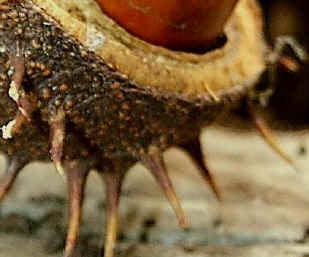Correct!
Mystery Picture Answers
No.11
|
The shell and fruit of the deciduous Horse-Chestnut tree Aesculus hippocastanum. Although the Horse Chestnut tree is quite common in many parts of the U.K., it is not a native of Britain but originates from South East Europe. It was introduced into Britain during the seventeenth century. Mature trees are large and wide, growing to between 25 - 35 metres tall. The bark of the trunk is dark and very rough. The tree flowers during April-May while the leaves emerge from large sticky buds. During the summer the seeds form which are dropped from the tree during early Autumn. The green spiny shell of the seed (above) splits open to reveal 1, 2 or 3 large and hard shiny brown fruits. Their size means they are too big to be dispersed by wind. Instead Horse Chestnut seeds are dispersed from the parent tree by animals who collect them to eat during the autumn and winter. The animals sometimes store them in locations which are ideal for the fruit to germinate, and if overlooked the seeds may grow into a new Horse Chestnut tree. Unlike the similar Sweet Chestnut fruit, humans find that Horse Chestnuts are inedible. However, Horse Chestnut fruits (usually called 'conkers' in Britain) are very popular with children, who have 'conker fights' to discover who has the champion hardest conker! The conker is suspended by a piece of string and your opponent strikes it with their own conker. The winner is the person whose conker survives.
|
Back to Mystery Picture Gallery

